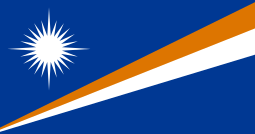Flag of the Marshall Islands
 | |
| Use | National flag |
|---|---|
| Proportion | 10:19 |
| Adopted | May 1, 1979 |
| Design | A blue field with two diagonal stripes of orange and white radiating from the lower hoist-side corner to the upper fly-side corner and the large white star with four large rays and twenty small rays on the upper hoist-side corner above the stripes. |
| Designed by | Emlain Kabua |

The flag of the Republic of the Marshall Islands, an island nation in the Pacific, was adopted upon the start of self-government, May 1, 1979. The flag was designed by Emlain Kabua, who served as the first First Lady of the republic.[1]
Rules and specifications regarding the flag are set forth in the Official Flag of the Marshall Islands Act 1979 (Public Law 1979–1).[2]
History
The Marshall Islands were part of the Trust Territory of the Pacific Islands administered by the United States, from which the Marshall Islands, Palau, and the Federated States of Micronesia split. In common with other island nations in the region, this flag features the symbolic representation of the islands' place within the ocean. The rising diagonal band represents the equator, the star above representing this Northern Hemisphere archipelago. The white and orange portions of the band represent, respectively, the Ratak Chain ("sunrise") and the Ralik Chain ("sunset"), as well as symbolizing peace and courage. The star's 24 points represent the number of electoral districts, while the four elongated points represent the principal cultural centers of Majuro, Jaluit, Wotje and Ebeye. The flag is also the national flag with the most points on a star, at 24.
This flag placed ninth out of 72 - the best flag of an independent nation that isn't Canada or the United States, instead being in a free association with the United States - in a North American Vexillological Association poll that was held in 2001.[3]
 Flag of The Jaluit Company from 1885 to 1906
Flag of The Jaluit Company from 1885 to 1906 Flag of The German New Guinea from 1906 to 1914
Flag of The German New Guinea from 1906 to 1914 Flag of Governor of the South Seas Mandate from 1920 to 1944
Flag of Governor of the South Seas Mandate from 1920 to 1944 Flag of the Trust Territory of the Pacific Islands; was used in the RMI from 1965 to 1979
Flag of the Trust Territory of the Pacific Islands; was used in the RMI from 1965 to 1979 The flag of the United States with 48 stars was also used in the RMI from 1944 to 1959 (see Timeline of the flag of the United States for more information on the stars on this flag increasing in number)
The flag of the United States with 48 stars was also used in the RMI from 1944 to 1959 (see Timeline of the flag of the United States for more information on the stars on this flag increasing in number)
Subnational flags
- Flag of Ailuk Atoll
 Flag of Bikini Atoll from 1987 to the present
Flag of Bikini Atoll from 1987 to the present- Flag of Ebon Atoll
- Flag of Kwajalein Atoll
- Flag of Majuro Atoll
- Flag of Namdrik Atoll
- Flag of Ujae Atoll
- Flag of Wotho Atoll
Specifications

The flag has a ratio of 10:19. The star is situated such that its center is equidistant from the left edge, the top edge, and the top of the orange ray.
Colors
| Scheme | Dark Powder Blue | Fulvous | White |
|---|---|---|---|
| RGB | 0-56-147 | 221-117-0 | 255-255-255 |
| CMYK | C1-M0-Y0-K42.3 | C0-M47-Y100-K13.3 | C0-M0-Y0-K0 |
| HEX | #003893 | #DD7500 | #FFFFFF |
References
- ^ "RMI Flag". Office of the President of the Marshall Islands. Archived from the original on August 5, 2013. Retrieved September 16, 2015.
- ^ "Marshall Island Revised Code 2014 (1 MIRC Ch. 3)". paclii.org. Pacific Islands Legal Information Institute. Archived from the original on February 25, 2021. Retrieved September 1, 2016.
- ^ Kaye, Edward B. (June 10, 2001). "2001 State/Provincial Flag Survey" (PDF). Archived (PDF) from the original on August 14, 2016. Retrieved February 3, 2024.
External links























